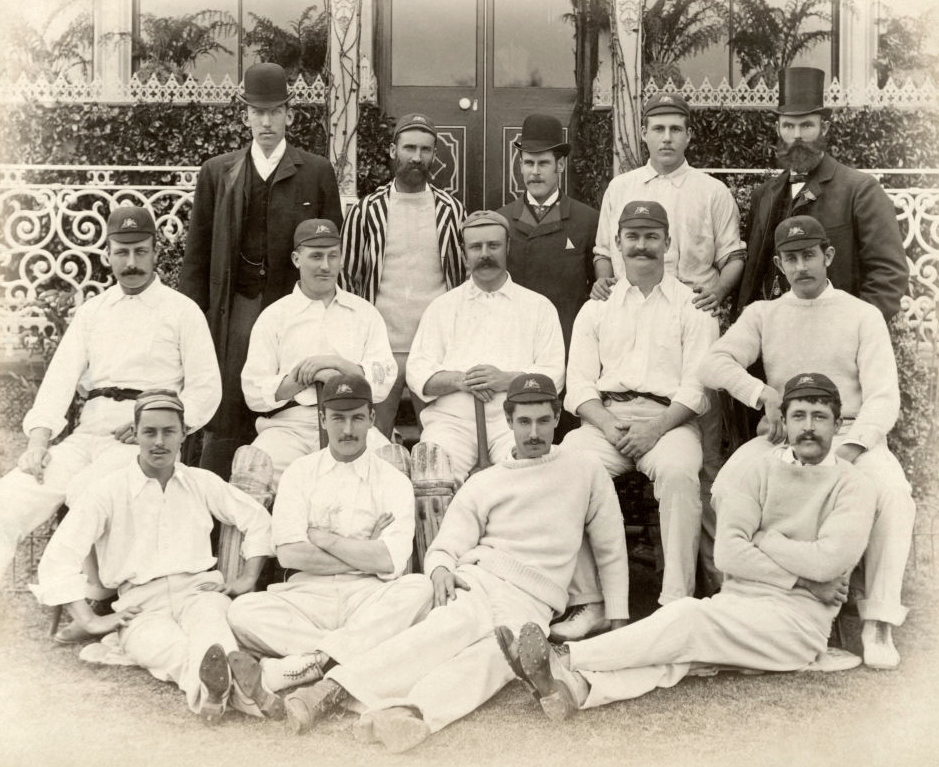Kenneth Burn on:
[Wikipedia]
[Google]
[Amazon]
Edwin James Kenneth Burn (17 September 1862 – 20 July 1956) was an Australian
 In his
In his
cricket
Cricket is a bat-and-ball game played between two teams of eleven players on a field at the centre of which is a pitch with a wicket at each end, each comprising two bails balanced on three stumps. The batting side scores runs by striki ...
er who played in two Tests
Test(s), testing, or TEST may refer to:
* Test (assessment), an educational assessment intended to measure the respondents' knowledge or other abilities
Arts and entertainment
* ''Test'' (2013 film), an American film
* ''Test'' (2014 film), ...
on the tour to England in 1890. Although unsuccessful at Test level, Burn is best known for being one of the most prolific batsmen in Tasmania at club level in the nineteenth century.
Club career
Burn was a prolific batsman in Tasmanian cricket for many years, playing first for his hometown side Richmond Cricket Club, and then the higher profile Wellington Cricket Club. He hit 41 centuries in all grades of cricket, two of them over 350 runs, and six of them in consecutive innings in the 1895–96 season. Without peer, he was undoubtedly Tasmania's best batsman of the 1890s at club and first-class level, leading theTasmanian Grade Cricket
Cricket Tasmania Premier League, or Tasmanian Premier Cricket, refers to the hierarchically graded cricket competitions played in Tasmania, Australia. The Cricket Tasmania Premier League comes under the administration of the Tasmanian Cricket Assoc ...
batting averages on 11 occasions throughout his career. He also set two long-standing Australian club cricket records by scoring 1,200 runs at an average of 133.00 in the 1889–1900 season, and in scoring 123 not out
In cricket, a batter is not out if they come out to bat in an innings and have not been dismissed by the end of an innings. The batter is also ''not out'' while their innings is still in progress.
Occurrence
At least one batter is not out at t ...
and 213 not out for Wellington against Break O'Day in 1895–96, he became the first man to score a century and double century in the same match in Australia. By the time of his retirement from club cricket, Burn had amassed 12,163 runs, which is still the second highest total in the competition's history. Only Ronald Morrisby
Ronald Orlando George Morrisby (12 January 1915 – 10 June 1995), was an Australian cricketer who played first-class cricket for Tasmania from 1931 until 1952. He can be considered one of the most outstanding Tasmanian batsman of his era, a ...
who made 16,000 runs in the 1950s has a higher total. Burn also took 362 wickets in his club career.
First-class career
 In his
In his first-class cricket
First-class cricket, along with List A cricket and Twenty20 cricket, is one of the highest-standard forms of cricket. A first-class match is one of three or more days' scheduled duration between two sides of eleven players each and is officiall ...
career, which lasted from the 1883–84 season through to 1909–10, he made two centuries, with 119 the higher. He also managed to take 14 wickets at the respectable average of 22.85 with his right-arm medium pace bowling
Fast bowling (also referred to as pace bowling) is one of two main approaches to bowling in the sport of cricket, the other being spin bowling. Practitioners of pace bowling are usually known as ''fast'' bowlers, ''quicks'', or ''pacemen''. T ...
. Burn was also Tasmania's first successful first-class captain
Captain is a title, an appellative for the commanding officer of a military unit; the supreme leader of a navy ship, merchant ship, aeroplane, spacecraft, or other vessel; or the commander of a port, fire or police department, election precinct, e ...
, leading the team to six victories in the 14 first-class matches that he led them for. His win percentage as captain of 42.85% has never been bettered.
Test career
Burn's selection for the Australian touring party in 1890 bordered on the farcical: he was picked as awicket-keeper
The wicket-keeper in the sport of cricket is the player on the fielding side who stands behind the wicket or stumps being watchful of the batsman and ready to take a catch, stump the batsman out and run out a batsman when occasion arises. Th ...
in what ''Wisden
''Wisden Cricketers' Almanack'', or simply ''Wisden'', colloquially the Bible of Cricket, is a cricket reference book published annually in the United Kingdom. The description "bible of cricket" was first used in the 1930s by Alec Waugh in a ...
'' termed "the one serious mistake in making up the side". Only after he had joined the team on the ship to England did he admit that he had never kept wicket.Lynch, S. "Where'd he come from", ''Cricinfo'', http://www.espncricinfo.com/ci/content/story/493063.html?CMP=NLC-DLY Retrieved 22 December 2010.
Burn played in the first two Tests on the tour, both of them lost. In the first, he batted at No 10 and No 11; in the second, he was promoted to No 6 in the first innings and opened in the second innings. In all, he scored 41 runs.
At the time of his death at the age of 93 years and 307 days, Burn was the oldest living Test cricketer. His obituary in the 1957 ''Wisden'' calls him "Kenneth Edward Burn". The Lower Domain Road gates at Hobart's TCA Ground
The TCA Ground, or Tasmanian Cricket Association Ground, is one of two first-class standard cricket grounds in Hobart, Tasmania. It is located on the Queens Domain less than one kilometre from the CBD.
The TCA Ground is a picturesque ground ...
are named the K. E. Burn Memorial Gates in his honour.
References
External links
* {{DEFAULTSORT:Burn, Ken 1862 births 1956 deaths Australia Test cricketers Tasmania cricketers Cricketers from Hobart Australian cricketers People from Richmond, Tasmania Colony of Tasmania people